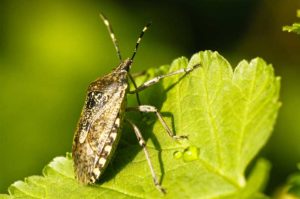Understanding, Preventing, and Eliminating the Brown Marmorated Stink Bug
 The National Pesticide Information Center reports on a new bug species that has quickly become a pest to both farmers and homeowners: the brown marmorated stink bug. Originating in Asia, this tiny critter poses no health risk to humans.
The National Pesticide Information Center reports on a new bug species that has quickly become a pest to both farmers and homeowners: the brown marmorated stink bug. Originating in Asia, this tiny critter poses no health risk to humans.
However, the brown marmorated stink bug does feed on fruit and vegetable crops. During the colder months, stink bugs will also look for shelter indoors, where they become an annoyance to those living in the homes. Read on to understand, prevent, and eliminate the brown marmorated stink bug from your property.
Identification
The first thing you’ll need to do is properly identify the pests you spot in your home so that you can take appropriate actions to remove them. An adult brown marmorated stink bug is brown in color with white bands around their antennae and darker shades of brown around their membranous.
Adult brown marmorated stink bugs measure 1-inch in length and width and have bodies that are in the shape of a shield. Finally, stink bugs have metallic colored small round holes on both their head and pronotum.
You may also spot the stink bug in one of its other stages. Brown marmorated stink bug eggs are generally found underneath the leaves in your garden and are yellow to yellowish-red in color. You’ll usually discover 20-30 eggs together in one clump. The nymphs are tiny versions of the stink bugs and they have a black head, legs, and thorax with red eyes.
Prevention
The best way to combat brown marmorated stink bugs is to follow a few preventative measures. Start off by taking a walk around the exterior of your home and caulking or sealing any cracks or crevices you come across, as stink bugs don’t need that big of a space to move from outdoors to indoors.
Next, take a look at the interior of the house and caulk around any heating ducts, outlets, or open spaces that could be a possible entry point. Don’t forget to fix any window and door screens that may have small holes, as stink bugs and other insects can also get in that way.
If you want a more thorough list of ways to prevent a stink bug infestation, seek advice from your local pest control expert. He or she will be able to come out to your home and point out spots you may not be aware of, such as potential entry points behind chimneys.
The exterminator can also apply a pesticide spray around the perimeter of your home during the months of September and October before the stink bugs are inclined to look for a warmer place to congregate.
Treatment
When brown marmorated stink bugs are already present, you’ll have to move from preventing them to eliminating them. Homeowners can attach a hose to their vacuum and suck up any stink bugs they come across. The bags should be emptied and placed in an outside trash can as soon as possible to eliminate the odors stink bugs are so famous for from filling the air in the home.
Larger infestations require intervention from a pest control specialist, as pesticides contain harsh chemicals that must be handled and applied properly. A few pesticides that work on stink bugs that may be used by your exterminator include bifenthrin, cyfluthrin, dinotefuran, and a-cyhalothrin. After the pesticides do their job, you can again break out your vacuum once again to clean up the dead stink bugs.
If you find stink bugs in your home, PermaTreat Pest & Termite Control can help. Our team of experts offers free inspections and has over 50 years of experience dealing with everything from termites to mosquitoes to rodent control.


































































